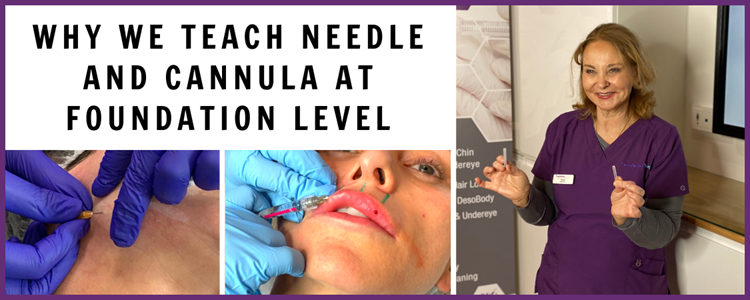
Reading time: approximately 4-5 minutes
We strongly believe that to become a safe, effective injector, it is important to master both needle AND cannula for the administration of dermal filler, right from the start of your training. At Facethetics, our Foundation Dermal Filler course covers the use of both methods. This puts our delegates ahead of many injectors, who often don’t come into contact with aesthetic cannula until they learn more advanced filler techniques.
So, what is the difference?
The main difference between cannula and needle is the design. Significantly, a cannula has a blunt tip, rendering it unable to pierce the skin. A sharp needle is still required for treatment with cannula, however, this is only used to create an entry point in the skin. Once the entry point has been created, the cannula can enter the skin to place the product. The blunt tip of the cannula pushes arteries and veins out of the way, reducing the risk of swelling, bruising and pain for your patient. Most importantly, the blunt tip also reduces the risk of more severe complications such as vascular occlusion, which can lead to tissue death and even blindness.
Conversely, needles have a thin wall and a sharp tip. This allows for easy penetration of the skin and the ability to place the product without too much pushing or manipulation by the practitioner. A further advantage of needles is that their smaller size enables better precision, as well as delivering product supraperiostially. Of course, the sharp tip of a needle also means that it is far easier to accidentally pierce and penetrate the wall of a vessel, potentially placing product into the vessel itself and preventing the flow of blood.
All dermal fillers come packaged with needles and, more recently, some dermal fillers, such as Belotero Volume, actually include both a needle and a cannula, allowing the practitioner to select the most appropriate method for the treatment. Of course, if a dermal filler product does not include a cannula, injectors can purchase these separately.
At Facethetics, we will guide you during your training journey to understand which areas are better treated with a needle and which are better treated with a cannula.
Cannula VS Needle
Injecting dermal fillers using blunt ended cannulas (also sometimes referred to as microcannulas) has become extremely popular over the past decade, with a shift away from using sharp needles.
Why?
This can be attributed to improved safety, reduced pain and improving the patient experience. However, there are risks and benefits to both methods, which can affect the patient’s safety, comfort and treatment experience.
Here is a quick review of the advantages of using a cannula;
Reduced bleeding, bruising and risk of vascular occlusion
An often-voiced concern when using a needle to deliver dermal fillers is that there can be significant bruising and swelling. We often hear the phrase “you bruise them you lose them” as patients may choose to go to a different practitioner or clinic if they experience post-treatment swelling or bruising.
In addition to the fear of causing a bruise, is the fear that the needle will pierce an artery and cause a vascular exclusion, potentially leading to infection, death of the tissue and, in very rare cases, catastrophic blindness.
These risks are MUCH lower when using a cannula because the tip is blunt and not sharp enough to rupture vessels. Although this will also depend upon the gauge of the cannula and also the technique and skill of the injector.
It’s important to remember that a higher gauge, narrower, sharper cannula when used with aggressive, forceful injecting technique can still lead to complications. Conversely, a wider cannula, eg 25 gauge, with a slow, gentle technique significantly reduces the risk of complications.
Fewer entry points = less discomfort
As cannula are longer and more flexible than needles they don’t require multiple entry points. One entry point allows you to cover and treat a larger surface area, and, at the same time, reduce bruising.
The slight resistance as a cannula passes through the tissue gives the injector an opportunity to adjust the pressure or change the direction. Some patients may feel the cannula passing through the skin, which, whilst not painful, is often described as an “odd”sensation.
So, is a cannula better than a needle?
In conclusion, the use of cannula can improve the patient experience by reducing downtime, allowing the patient to return to normal activities immediately without the bruising and swelling more commonly associated with needles. It can also allow for a more comfortable treatment.
However, it is important to note that a cannula still comes with risks AND there are certain treatments where a needle is better suited. As an aesthetic practitioner, the key is being able to confidently and correctly utilise both methods and identify when one is preferable to the other. At Facethetics Training, we give you the knowledge, skill and confidence to choose between needle and cannula, and use both safely and effectively.
By always being able to carry out the most appropriate method for the indication, you will ensure that your patients always have a good experience during their treatment, AND that you deliver the best possible result.
It is through giving your patients the best experience and results that enables you to retain them, hopefully for years to come, while also giving yourself a competitive edge against other practitioners.
Ready to book onto Foundation Dermal Filler and become a confident, knowledgeable and skilled aesthetic practitioner? Click here to complete our application form!
